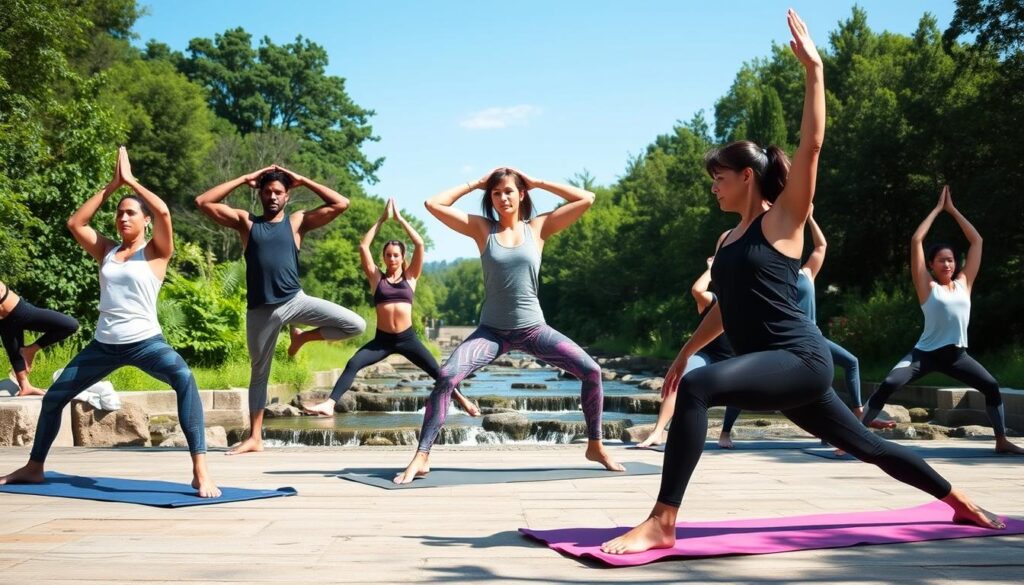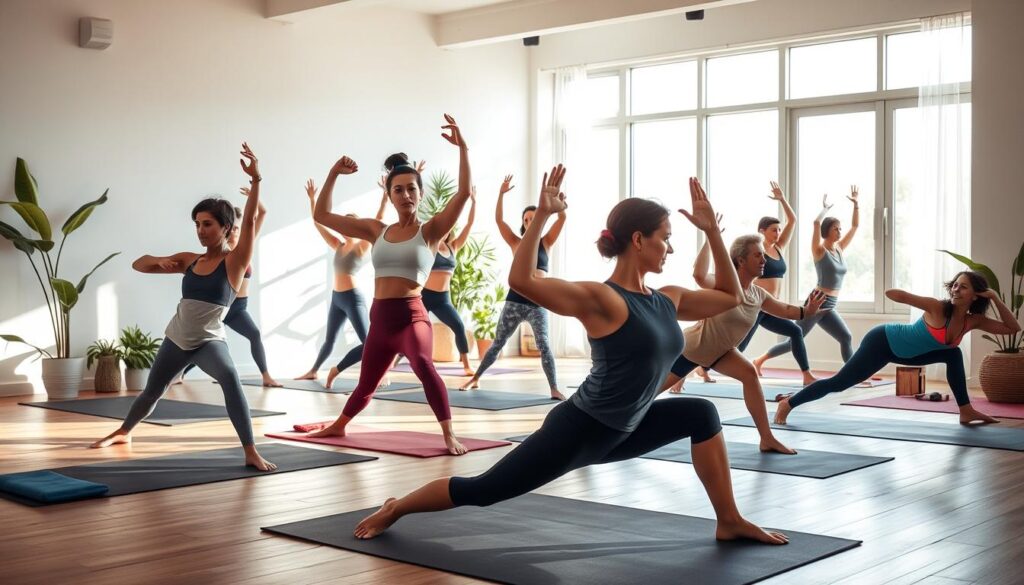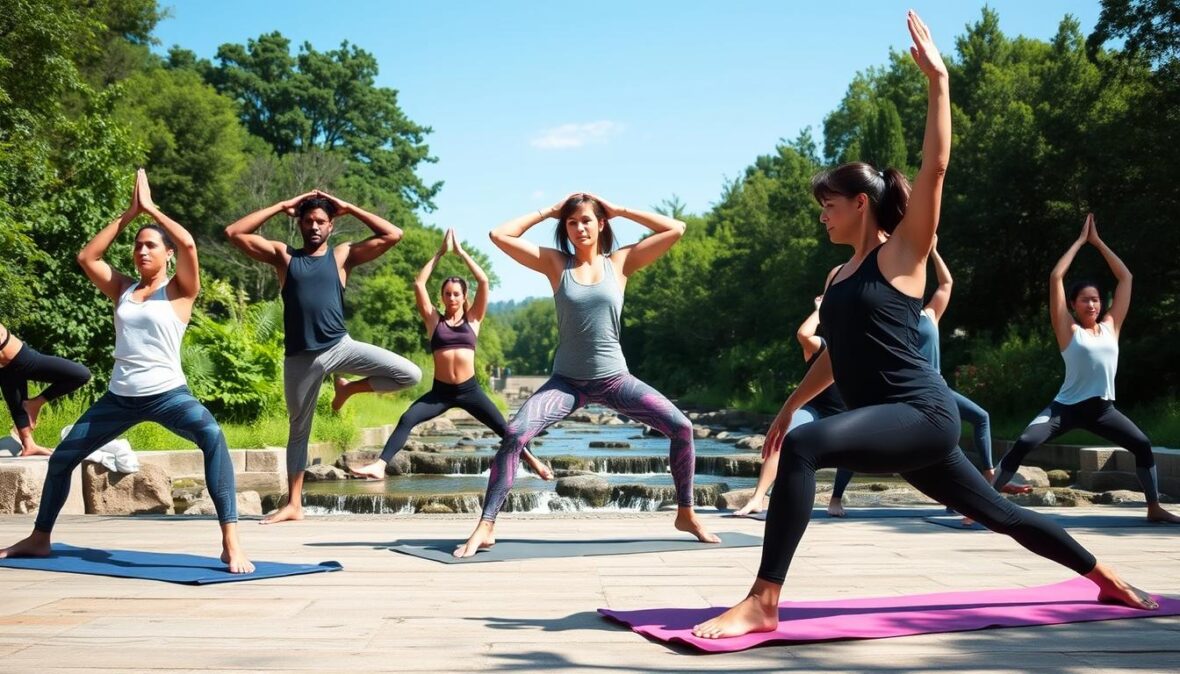Many think yoga is just for flexibility and relaxation. But yoga can also help build muscle and boost strength. It focuses on both big and small muscles, often missed in regular workouts.
By doing strength-focused yoga poses regularly, you can see real muscle growth. Your body will also become more stable.
Yoga poses like Forearm Plank and Tree Pose work on muscles and improve tone. This makes yoga a great part of any fitness plan. It’s time to see yoga’s true strength-building potential.

Key Takeaways
- Yoga poses can build muscle in smaller muscle groups often overlooked in gym workouts.
- Regular practice leads to significant strength gains and improves stability.
- Holding poses for longer durations enhances strength-building effects.
- Yoga can be as effective as weight training for muscle development.
- Incorporating variety in yoga poses accelerates fitness results.
- Yoga reduces injury risk while conditioning the body for everyday movements.
Understanding Yoga as a Form of Strength Training
Yoga is a unique way to build strength, using your body’s weight as resistance. It’s different from lifting weights, which targets specific muscles. Yoga strengthens muscles all over, improving stability and control for everyday tasks.
Experts like Rodney Yee say yoga poses work many muscles, even the small ones. These muscles, along with connective tissues, get stronger and more flexible. People notice better muscle tone and balance from yoga’s full-body approach.
Yoga can also lower the risk of injuries to ligaments and tendons. It strengthens the core, improving posture, flexibility, and coordination. Studies show yoga boosts functional strength, balance, and mobility.
The pace of muscle building in yoga depends on the type and frequency of practice. A 2015 study found yoga can increase muscle strength in 12 weeks. This shows yoga is as effective as light weights and resistance bands for building strength.
What Does It Mean to Build Muscle?
Building muscle, or hypertrophy, is a process where muscles get stressed and then repair. This makes them bigger and stronger. When you do hard workouts or yoga, your muscles get tense. This tension makes your body get stronger.
Many things affect how muscles grow, like the type of muscle fibers and how you train. Also, how well you recover is important.
Muscle definition is about how clear your muscles look. You can get this by working out regularly and eating right. A 2015 study in Evidence-Based Complementary and Alternative Medicine showed yoga can make muscles stronger in just 12 weeks. This means yoga can help make muscles look better too.
Progressive overload is key to building muscle. It means you keep making your muscles work harder. Yoga can get harder as you do it more, helping you grow stronger. A study in the European Journal of Applied Physiology found that holding yoga poses for longer helps muscles grow.
A study in the Journal of Strength and Conditioning Research found yoga pushups can be as good as bench-pressing for upper body strength. This shows yoga exercises can help build muscle. Mixing yoga with traditional strength training can help you grow muscle even more.
Can You Get Muscles from Yoga?
Many people wonder if you can build muscles from yoga. The truth is in how yoga uses body weight to build strength. Holding yoga poses requires a lot of muscle power. This resistance helps build muscle tone and size over time.
Exploring the Role of Body Weight
Yoga’s use of body weight is key to building lean muscle. A 2015 study found that yoga can improve muscle strength in just 12 weeks. It’s not just about muscle size; it’s about control and stability too.
For example, yoga pushups can be as effective as bench-pressing for upper body strength. This shows that body weight can lead to significant strength gains.
Yoga’s Influence on Muscle Tone
Muscle tone is shaped by the contractions in yoga. Yoga combines isometric and isotonic contractions to shape muscles. This helps build strong arms, shoulders, and core.
Regular yoga practice increases muscle endurance and helps you look leaner. Studies show that consistent, challenging yoga sessions help muscles grow. Faster yoga styles, like vinyasa, can also help build muscle when combined with strength training.
In the end, achieving muscle tone depends on regular practice, a good diet, and staying fit.
Different Types of Yoga for Building Strength
Yoga has many styles, each helping in different ways to build strength. Power Yoga and Vinyasa are fast-paced, building muscle and endurance. Hatha Yoga is more about building a strong base and improving daily fitness. Knowing these styles helps pick the right one for your fitness goals.
Power Yoga and Vinyasa
Power Yoga comes from Ashtanga Yoga, using quick sequences to boost flexibility and muscle. It makes you move fast, raising your heart rate and strengthening muscles. Vinyasa Yoga is similar but focuses on smooth transitions, working out many muscles at once. Both involve holding poses to activate and grow muscles.
Hatha Yoga and Functional Fitness
Hatha Yoga is yoga’s foundation, focusing on proper alignment and holding poses long. It strengthens the body and improves daily fitness. It works many muscles, helping tone them. Starting with Hatha Yoga builds a strong base for more challenging yoga, supporting strength growth.
| Yoga Style | Focus Area | Benefits for Building Strength |
|---|---|---|
| Power Yoga | Dynamic and vigorous flowing sequences | Increased muscle tone and enhanced endurance |
| Vinyasa | Fluid transitions between poses | Strengthens multiple muscle groups through movement |
| Hatha Yoga | Alignment-focused poses with longer holds | Foundational strength and functional fitness improvement |
Benefits of Yoga for Muscle Growth
Yoga is great for building muscle and improving overall health. It helps increase muscle endurance through poses that challenge you. This is key for muscle repair and growth.
Increased Muscle Endurance
Yoga boosts muscle endurance. A study found that women who did Hatha yoga got better at pushups and situps. This shows yoga’s power in building muscle endurance.
Functional Strength Development
Yoga makes daily tasks easier by building functional strength. It’s as good as light weights and resistance bands for strength gains. This makes yoga a smart choice for improving strength.
| Study | Findings |
|---|---|
| Evidence-Based Complementary and Alternative Medicine (2015) | Yoga improved muscular strength after 12 weeks. |
| Journal of Applied Physiology (2014) | Eccentric training in yoga is better for muscle size and strength than concentric training. |
| The Journals of Gerontology (2015) | Yoga equaled the effectiveness of light free weights for strength improvement. |
| International Journal of Environmental Research and Public Health (2021) | Yoga improves balance, mobility, flexibility, and functional movement. |
Top Yoga Poses to Increase Muscle Strength
Yoga poses are key for boosting physical strength and stability. This section focuses on three poses that help build muscle. Each pose has its own benefits and techniques.
Forearm Plank
The Forearm Plank is great for the core and upper body. It involves placing forearms on the ground and aligning the body straight. This engages muscles like the abs, shoulders, and back.
To do the Forearm Plank, follow these steps:
- Start on all fours, then lower your forearms to the mat.
- Step back one foot at a time, keeping your spine straight.
- Hold for 15 to 60 seconds, breathing steadily.
Tree Pose
The Tree Pose is good for balance and strengthens the legs. It’s about standing on one leg with the other foot on the inner thigh. This pose helps with stability and focus.
Here’s how to practice Tree Pose:
- Stand tall with feet together, grounding on one leg.
- Lift the opposite foot and place it on the inner thigh or calf, avoiding the knee.
- Bring your hands together at heart center and focus on a point in front of you.
- Hold for 15 to 60 seconds before switching sides.
Crow Pose
Crow Pose is a tough pose that strengthens arms and core. It requires balancing knees on the backs of the arms while leaning forward. Here’s how to master Crow Pose:
- Start in a squat position with feet close together.
- Place your hands on the ground shoulder-width apart, fingers spread wide.
- Lift your hips and start to shift your weight onto your arms.
- Rest your knees on your triceps and lift your feet off the ground, finding balance.
- Hold for 15 to 60 seconds, focusing on your breath.
Doing these poses three times a week for 30 minutes each can improve muscle tone and fitness. Each pose strengthens specific muscles and boosts concentration, balance, and well-being.
How Yoga Compares to Traditional Weight Training
When comparing yoga to traditional weight training, we see some key differences. Weight training is often seen as better for building muscle. It lets you control the weight and resistance, which works more muscle fibers. This leads to bigger muscle growth than yoga.
Yoga, on the other hand, focuses more on strength endurance than muscle size. It uses poses like forearm planks and crow poses to build overall strength. These poses also help keep joints stable and healthy.
Both yoga and weight training have their own benefits. Yoga improves balance and flexibility and helps you feel more connected to your body. It also helps with faster recovery after workouts. This is because yoga stretches and strengthens muscles together.
Combining yoga with weight training can be the best choice. It gives you the benefits of both worlds. You get the joint stability and muscle endurance from yoga, and the muscle growth from weight training.
Creating a Balanced Workout Routine
Adding yoga to your workout routine can really boost your fitness. A good mix includes cardio, strength training, and yoga. This combo helps with flexibility and building muscle.
Yoga is special because it uses your body weight for strength training. It helps build lean, long muscles. Styles like Vinyasa Flow and Ashtanga Yoga are great for muscle building and improving flexibility.
Try alternating between strength training and yoga days. Spend 30-45 minutes on strength training. Then, do a yoga class or session to boost flexibility the next day. This helps your muscles recover and perform better.
It’s important to listen to your body while doing yoga. Proper alignment is key to getting the most out of your workout and avoiding injuries. Doing strength training and yoga on the same day can work if you give your muscles time to recover. A balanced routine with yoga can make your workouts more effective, help you recover faster, and improve your overall health.
Tips for Maximizing Muscle Development Through Yoga
To build muscle through yoga, you need a smart plan. Focus on being consistent and use resistance training. This way, you can make your yoga better and grow muscles well.
Consistency and Progression
Having a regular routine is key for muscle building in yoga. Regular practice boosts your skills and increases your strength slowly. Make sure to schedule yoga often to see real changes in your body. You can progress by:
- Increasing the challenge of poses.
- Trying new versions of poses you know.
- Setting goals, like holding poses longer.
Incorporating Resistance
Adding resistance training to your yoga can help grow muscles more. Use tools like resistance bands or light weights. For example, bands in Squats or weights in Warrior poses can make a big difference. Studies show yoga can be as good as light weights for getting stronger.

The Importance of Core Strength in Yoga
Core strength is key for fitness, boosting stamina, control, balance, and energy. Yoga poses like Plank and Boat Pose help build this strength. They target the core muscles, improving stability.
Core-Focused Poses: Boat Pose and Plank
The Boat Pose and Plank are crucial for core strength. The Boat Pose works the abdominals, lower back, hips, and glutes. It aligns the spine and boosts core stability.
The Plank pose is a great drill for the core. It requires the abdominal muscles to keep the body straight. These poses help build strength and prepare for more challenging poses.
Benefits of Core Stability
Strengthening the core has many benefits. It improves posture, reducing back pain and slouching. It also helps prevent injuries in yoga and workouts.
A strong core makes balancing easier, allowing for more advanced poses. Regular practice of core-focused poses improves flexibility and mental health.
Common Misconceptions About Yoga and Muscle Building
Many people think yoga can’t help build muscles. They believe it’s only for stretching and not for strength. But yoga is more than that. It helps tone muscles and improve strength in a unique way.
Yoga works by using different poses to engage muscles. This helps build strength without needing heavy weights. It’s a great way to get fit without the usual gym routines.
Some think yoga is only for women. But, around 70% of yoga fans in the U.S. are men. Yoga is for everyone who wants to get stronger and fitter.
Studies show yoga can really improve your body. A 12-week yoga program boosted strength, endurance, and flexibility in healthy adults. Yoga offers many benefits, just like traditional workouts.
Here’s a look at what’s true about yoga and muscle building:
| Myth | Reality |
|---|---|
| Yoga cannot build substantial muscle. | Yoga enhances muscle tone and functional strength. |
| Yoga is just stretching. | Yoga incorporates strength-building poses that engage various muscle groups. |
| Only women practice yoga. | 28% of yoga practitioners in the U.S. are male; yoga is inclusive of all genders. |
| Yoga is not a serious workout. | Yoga can improve muscle strength and cardiovascular conditioning. |
| Yoga requires a lot of time commitment. | Sessions can be as short as five minutes and still be effective. |
Knowing the truth about yoga and muscle building can change how we see it. Yoga is flexible and can fit into anyone’s fitness plan. It’s a great way to work out and improve your health.
The Role of Nutrition in Muscle Growth with Yoga
Nutrition is key when you’re doing yoga to build muscle. You need a diet full of protein, healthy fats, and carbs. These help repair muscles and give you energy. This mix makes your yoga better and helps you get fit faster.
After yoga, eating the right foods is important for muscle repair. You should eat lean proteins like chicken, fish, tofu, and legumes. These give you the amino acids you need. Add complex carbs like quinoa, brown rice, and whole grains for energy all day.
Don’t forget to drink water too. It helps with digestion, nutrient absorption, and muscle function. Drinking water before, during, and after yoga boosts your strength and health.

If you do yoga that builds muscle, like Ashtanga or Power Yoga, eat snacks like Greek yogurt with fruit or a protein smoothie after class. These snacks help with energy and muscle repair. Also, healthy fats from avocados or nuts are good for your body and keep you energized.
| Food Type | Benefits | Examples |
|---|---|---|
| Protein | Supports muscle repair | Chicken, fish, tofu, legumes |
| Complex Carbohydrates | Provides sustained energy | Quinoa, brown rice, whole grains |
| Healthy Fats | Supports overall health | Avocados, nuts, seeds |
In short, combining yoga with the right nutrition helps you grow muscle and get fit. By paying attention to what you eat and how you exercise, you can make your yoga workouts more effective.
Conclusion
Yoga is a great way to build muscle, even if it doesn’t make you as big as weightlifting. It helps you get stronger, more flexible, and more fit. Studies show yoga can boost your muscle strength and endurance if you do it often.
Adding yoga to your workout routine can make you stronger and more balanced. People who do yoga regularly see big improvements in their fitness and mental health. It’s not just about getting stronger; it’s about feeling better overall.
Yoga is more than just a workout; it’s a way to heal and get stronger. It helps you recover faster and build muscle. By combining yoga with other exercises, you can reach your fitness goals and feel amazing.



